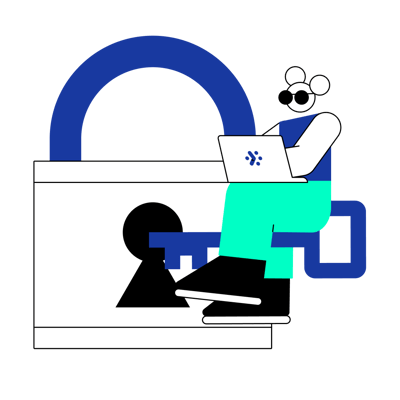To illustrate the benefits of data integration in action, US performance marketing consultancy Digital Matter found that they were spending a large amount of time manually putting together static reports in Excel for each of the marketing channels they managed for clients. By embracing data integration, they were able to access all the information they needed across multiple channels in one place - all neatly standardized and harmonized for client reporting. This hugely improved their operational efficiency and made it faster and easier to deliver accurate reports to their clients.
 Streamlining data integration improves operational efficiency.
Streamlining data integration improves operational efficiency.Challenges of manual data integration
Technically, it is possible to implement data integration manually. But it’s not advisable.
Manually accessing data from multiple locations, standardizing it, and uploading data to a centralized location is a time-consuming task that can drain business resources and also demotivate team members, leading to reduced productivity.
It also comes with a risk of human error, which means that companies could make decisions based on inaccurate or incomplete data that are likely to then impact their overall business performance.
Other common challenges associated with manual data integration include:
Scalability
A business might be able to temporarily support manual data integration if they only have two or three sources of data - as an example let’s say Google Ads, Facebook Ads, and Bing Ads.
But as businesses scale, the number of data sources that need to be analyzed is also likely to grow. The manual process that worked for a couple of data sources becomes completely unmanageable when you’re trying to consolidate a much larger number.
Manual data integration just doesn’t have the scalability that growing businesses need.
Maintenance
When you rely on manual data integration, maintaining your data can become a complex task.
For example, let's imagine you need to modify a field or update some records from a data source. If you’re integrating data manually, you’ll need to keep track of all the different spreadsheets and databases where you need to amend those records.
It can be easy to make an oversight and not correctly update or maintain data in a certain destination which leads to the business making decisions on inaccurate data.

Accuracy of data
If your business is going to make important decisions based on data, they need to trust it. Yet a survey we ran in 2022 found that 41% of marketing data analysts do not fully trust the data they are working with.
Relying on manual data integration invites the element of human error into your business intelligence and reporting - such as misspellings, duplicate data, and inconsistencies in naming conventions.
Availability
Another challenge with manual data integration is making sure that the business has access to timely, up-to-date data.
The time it can take to manually integrate a dozen different data sources means it’s unlikely that the process can be completed multiple times each day. If a business is relying on manual data integration, another thing they need to consider is what happens when the person responsible for the process goes on leave or takes a day off sick. The options are likely to be that either data isn’t updated for a certain period, or the complex task is handed to another team member which increases the likelihood of errors.
Governance
Manual data integration can also lead to challenges around data security, data governance, and data regulation compliance.
By downloading data from multiple sources and manually transforming it, you’re handling a lot of data manually without enforceable security measures which increases the risk of data breaches.
And if you’re working with personally identifiable information, having a manual data integration process puts you at risk of oversights that can lead to non-compliance with data regulations such as GDPR (General Data Protection Regulation).
 Manual data integration puts you at risk of violating GDPR.
Manual data integration puts you at risk of violating GDPR.Benefits of automated data integration
If your business is still relying on manual data integration, you’ll now appreciate why switching to automated data integration is a good idea.
By embracing automated data integration you can experience benefits such as:
- Improved data accuracy
- Improved data governance
- More recent and timely data
- Freeing up time within the business
- A solution that can scale as your business grows
- Better data to make important business decisions
Book a demo to see how you can unlock the potential of your business data with automated data integration.
Data integration techniques
There are two main data integration techniques that can be used if your business is looking to move away from manual data integration and towards a more real-time, automated process.
Fetch data
Fetch data integration operates on a scheduled basis and ensures that the data is refreshed regularly to maintain its relevance. This is the method that most data integration platforms use.
A basic example might be capturing performance data across multiple marketing channels and your email service provider at a fixed time each day, transforming it for standardization, and uploading it to a data warehouse so your marketing team has stats ready for them the next working day.
For businesses that are looking for more real-time data to base their decisions on, Adverity offers the most frequent fetch rate in the industry.
7 data integration best practices
Every business is unique and will have a slightly different approach to data integration.
However, there are some best practices that are relevant no matter how you approach things.
1. Identify data sources
The first step in the data integration process is identifying the data sources that you want to include in your centralized source of truth.
One of the biggest pieces of advice we could give people starting on their automated data integration journey is that just because you can, it doesn’t mean you should.
Automated data integration provides an efficient and easy way of integrating data from multiple sources - but it’s still important to make sure that the data you’re extracting, transforming, enriching, and loading is aligned with business objectives.
Bringing in data that isn’t likely to get used is going to do nothing more than increase your storage costs. So it’s worth working within the business to define the important data that can really help shape your business decisions.
Most automated data integration platforms have a library of pre-built connectors to help businesses easily connect to popular data sources.
Adverity has more than 600 pre-built data connectors and the ability to create links to custom data sources - so you’re able to connect with any business data source you want.
Explore hassle free data collection
2. Create a data integration plan
Creating an integration plan is another data integration best practice - it’s essential for a successful project that is well-organized, efficient, and aligned with business goals.
After understanding the business objectives for data integration, an integration plan should cover key aspects such as:
- Data integration architecture design
- Schema mapping and naming conventions
- Transformation and enrichment requirements
- A governance plan to maintain the solution over time
3. Standardize naming conventions
Your naming conventions relate to naming of the fields and values in your standardized data set.
By clearly defining your naming conventions, you can determine how your data is transformed, presented, formatted, and structured in a way that is easily understandable to the business.
It’s one of the most important parts of an effective data integration plan, and something that should be considered a data integration best practice.
Adverity has advanced Smart Naming Convention enrichments to help protect the quality and accuracy of your data - monitoring your data to make sure it complies with your naming conventions, and notifying you about any anomalies.
Effortlessly clean your data at scale
4. Transform and enrich data
Data transformation is the process that allows you to take all your data from disparate sources and standardize it, before loading it into your data warehouse or data lake as a single source of truth.
Most data integration platforms support data transformation. But it’s important to choose a solution that allows you to get the most out of your data.
Adverity also allows businesses to use different data enrichments - actually enhancing data for better usability by automatically standardizing currencies and translating languages within your data.
5. Choose the right data integration platform
There are dozens of automated data integration platforms available - each having its own strengths and weaknesses, and serving different types of business.
It’s data integration best practice to ensure that you choose a solution that is aligned with your business goals and objectives.
It’s important to weigh up not only your current data needs - but also what you’re likely to need in the future. It’s important to make sure your data integration platform can support where you want to go as a business - not just your immediate requirements.
Another thing that you might want to consider is the internal technical capabilities within your business. Some solutions are set up to be incredibly user-friendly, with hundreds of pre-built data connectors and an intuitive UI. Other solutions require a bit of coding knowledge - so make sure you’re not taking on a platform that the team won’t be able to use to its fullest extent.
One of the best ways to understand if a data integration platform is the right fit for your business is to ask for a demo or a trial. You can’t beat hands-on experience with a platform to truly understand how well it meets your specific business needs.
6. Data management and control
However you choose to integrate data across your business, It’s important that you have data governance and security at the forefront of your mind.
Data governance is a bit of a catch-all term that refers to the policies, processes, and controls that ensure the quality, privacy, and security of data within your business.
Manual data integration can be tough to govern and implement strict controls over - there’s too much room for human error. Luckily, most automated data integration platforms have the functionality to help maintain the quality and accuracy of data and make sure everything complies with regulations and internal policies.
Adverity has a range of tools that can help give you peace of mind around data quality and security. It’s simple to set up access privileges to data by user - making sure your sensitive data is only seen by the people that need to see it. Data teams can also set up strict policies around how long any data should be retained before it’s deleted.
 Data governance and security should be at the forefront of your mind.
Data governance and security should be at the forefront of your mind.7. Make sure data is useful for the organization
The first 6 data integration best practice steps are all important to help you guarantee the quality, accuracy, standardization, and compliance of your business data.
However, it’s equally important to make sure that the data you’ve integrated becomes a powerful asset within your organization, delivering valuable and easy-to-understand insights to all teams within your business - and empowering them to make data-driven decisions.
Data integration will allow you to provide a unified view of all data. But for most businesses, there is likely to be a need for a business intelligence or data visualization tool like Power BI, Tableau, or Looker to help all business users analyze data and take action.
If you’re evaluating which data integration tool might be right for your business, it’s worth noting that some automated data integration platforms like Adverity include their own in-built analytics dashboards that help organizations easily visualize their real-time performance data.
Research the Adverity platform here
Invest in a comprehensive data integration platform like Adverity
Manual data integration processes have become obsolete in today’s competitive data-driven environment.
Choosing automated data integration provides your business with a wide range of advantages, including a single source of truth, improved data accuracy, access to near real-time data, time and cost savings, effortless scalability, robust data governance, and more valuable insights to make important business decisions.
By upgrading to a powerful data integration platform like Adverity, your business can unlock the full potential of your data - enabling users across your entire organization to access and analyze data like they never have before.
Experience the difference for yourself. Book a demo with Adverity and take the first step to transforming the way your business makes data-driven decisions.













